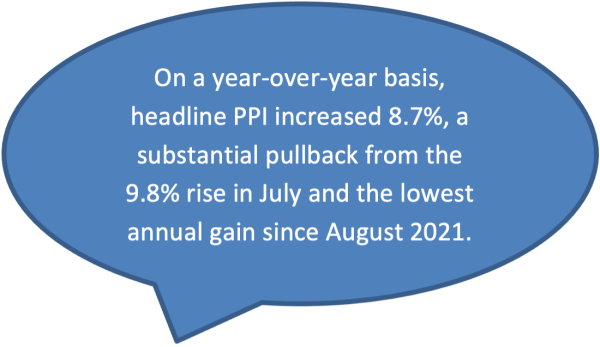Investment Commentary – September 14, 2022
Year to Date Market Indices as of September 14, 2022
- Dow 31,184 (-14.16%)
- S&P 3,948 (-11.12%)
- NASDAQ 11,709 (-22.09%)
- OIL $88.92 (17.64%)
- Barclay Bond Aggregate (–11.55%)
Wholesale prices fell 0.1% in August amid inflation fears
On a year-over-year basis, headline PPI increased 8.7%, a substantial pullback from the 9.8% rise in July and the lowest annual gain since August 2021. Core PPI increased 5.6% from a year ago, matching the lowest rate since June 2021.
 The prices that producers receive for goods and services declined in August, a mild respite from inflation pressures that are threatening to send the U.S. economy into recession.
The prices that producers receive for goods and services declined in August, a mild respite from inflation pressures that are threatening to send the U.S. economy into recession.
The producer price index, a gauge of prices received at the wholesale level, fell 0.1%, according to a Bureau of Labor Statistics report Wednesday. Excluding food, energy and trade services, PPI increased 0.2%.
Economists surveyed by Dow Jones had been expecting headline PPI to decline 0.1%.
On a year-over-year basis, headline PPI increased 8.7%, a substantial pullback from the 9.8% rise in July and the lowest annual gain since August 2021. Core PPI increased 5.6% from a year ago, matching the lowest rate since June 2021.
As has been the case over the summer, the drop in prices came largely from a decline in energy.
The index for final demand energy slid 6% in August, which saw a 12.7% drop in the gasoline index that was responsible for more than three-quarters of the 1.2% decline in prices for final demand goods. That helped feed through to consumer prices, which fell sharply after briefly surpassing $5 a gallon at the pump earlier in the summer.
Wholesale services prices increased 0.4% for the month, indicating a further transition for a Covid pandemic-era economy where goods inflation soared. Final demand services prices rose 0.4% for the month, with the balance of that coming from a 0.8% increase in trade services.
Those numbers come a day after the BLS reported consumer price index data for August that was higher than expected. The two reports differ in that the PPI shows what producers receive for finished goods, while the CPI reflects what consumers pay in the marketplace.
“The PPI report fleshes out the picture on inflation in the US, and makes it look not quite as bad as the August CPI report did,” said Bill Adams, chief economist for Comerica Bank. “Inflation is clearly slowing as gas prices fall. But the process is slow, and inflation looks set to stay well above the Fed’s target for at least a few more quarters.”
The PPI can be a leading indicator for inflation as wholesale prices feed through the economy. However, it’s importance has been tempered over the years as manufactured goods make up less of a share of total spending.
Following the Tuesday report, stocks tanked and expectations surged for Federal Reserve action at its meeting next week. Stock market futures were positive after the PPI report while Treasury yields were higher as well.
The views presented are not intended to be relied on as a forecast, research or investment advice and are the opinions of the sources cited and are subject to change based on subsequent developments. They are not a recommendation, offer or solicitation to buy or sell any securities or to adopt any investments.
https://www.marketwatch.com/ (Market Indices)
https://www.jhinvestments.com/weekly-market-recap (Around the Web & Upcoming Events)
https://finviz.com/groups.ashx (YTD Performance Chart)
https://www.cnbc.com/2022/09/14/producer-price-index-august-2022.html


Leave A Comment